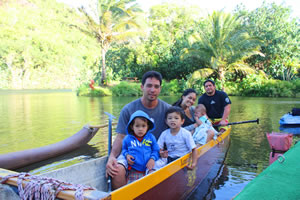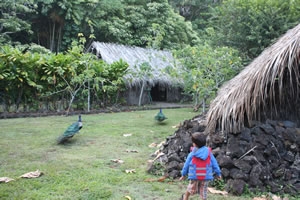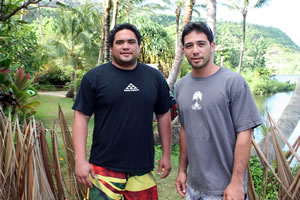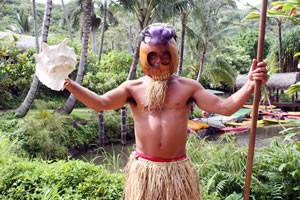Village People
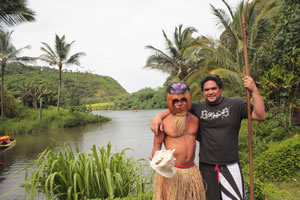
Down a steep road to Kamokila, on the banks of the Wailua River, for four generations the Fernandes ohana has created a Hawaiian village where the old ways prevail. Pictured here are ‘Warrior Man’ Punohu Kekaualua and Ben ‘Braga’ Fernandes, grandson of the founders. Amanda C. Gregg photo
There’s a place where the old Hawaiian ways still prevail, thanks to the dreams and work of four generations of the Fernandes ohana
The steep road to Kamokila is a charming segue to the sacred place that is Wailua River, and the little Hawaiian village housed there. A labor of love for the family that has worked to perpetuate Old Kaua’i for the rest of the world, the drive serves almost as a journey back in time, to a place that gives a sense of what life here used to be.
The Fernandes ohana has run Kamokila for four generations, and bumping along down into the village ends among thatched huts, petroglyphs and heiau, the latter of which lend a serene authenticity to the space and pay quiet homage to Kaua’i.
“This was my great-grandfather’s dream,” Kihei Fernandes says, referring to Ben Ohai, the patriarch of the Fernandes family, “to create a little piece of what Kaua’i once was, for everybody.”
Ohai wanted to create the Hawaiian village for years, but though he was able to find the site, he died before he could create it.
Ohai’s children and grandchildren built it (and rebuilt it following its destruction from hurricanes ‘Iwa and ‘Iniki), and now the great-grandchildren like Kihei Fernandes continue to keep the legacy going.
“My grandparents, Evelyn and Billy Fernandes, operated this village along with my father, Kimo, and my aunts Lehua Fernandes Salling and Maile Fernandes. My sister (Bree) and brothers (Ben “Braga” Fernandes, Nainoa, Kepa) and my cousins have all shared in making the village a unique experience,” Kihei says.
Though the family first opened Kamokila in 1979, they started the process in the ’60s. Just building the road along the steep descent to the Hawaiian village from Kuamo’o Road took four years. Part of the reason it took so long is because Kihei’s grandfather, who passed away last June, was a family man. Indeed, many likely remember Billy Fernandes as a family man, but also a forward-thinking politician and farmer. An electrician by trade, Billy was elected to the Territorial House of Representatives in 1952 and the state Senate before serving as a Kaua’i County councilman in the ’70s. For decades he continued to help bring what his father-in-law (Ohai) had envisioned to fruition, alongside his wife of 64 years, Evelyn Ohai Fernandes, a Native Hawaiian.
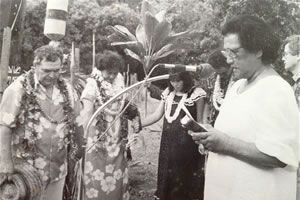
(from left) William ‘Billy’ Fernandes, Evelyn Fernandes, Stephanie Fernandes (pregnant at the time with son Kihei), Kimo Fernandes and the kahu (photo courtesy of Kihei Fernandes)
Evelyn says what she recalls most fondly about spending time down at Kamokila with her husband was simply “just being down at the village, with him.”
Not a gimmicky or tourist-centric place by any means, locals enjoy the property, too, Kihei’s wife Jaclyn says. “It’s also a nice place for first birthday party, luau, weddings and Sunday afternoons,” she says, adding that it serves as an educational site for keiki, too.
An idyllic setting for students, Stephanie, Kihei’s mom, says they want to educate people on how to get back to the Hawaiian sustainable way of life. “How self-sufficient the Hawaiian people are – their way of life supported and respected nature, the land that gave life to all from hunting in the mountains, growing and gathering food from the land, and fishing from the sea,” she says. “People took only what they needed to survive without depleting the natural resources.”
Nowadays Kamokila is visited by between 20 and 30 schools each year, including Hawaiian immersion schools, Hanalei and Kalaheo elementary schools and Kanuikapono charter school, along with schools from O’ahu and the Big Island.
It also is a place Kihei enjoyed visiting as a Kapa’a Elementary student, too.
“I remember feeling proud, like, ‘I grew up down here, this is where Grandma would take us and let us just go crazy and have fun, dance hula, teach us all about all the plants, Hawaiian herbs, fruits in season,'” he says.
Aiming to keep the educational and historic place alive and well is important to the family, and Kihei and his brothers have worked to have seasonal taro lo’i, as well as coconut weaving, and hat and basket demonstrations, hula and mana’o offered at the site by Aunty Ilima Rivera.
“We also offer games like spear throwing and Hawaiian bowling (ulu maika),” he says, adding that he’s often pleased when local people come down, especially those who may not have ever visited before. “I guess they always drove past the village and never came down even though they have lived here their whole life – but then when they experience it, they’re happy to know what’s down here.”
That can mean going for a 10- to 15-minute kayak paddle to the grotto, hiking to Uluwehi Falls, jumping in a swimming hole or just meandering the site and among the fruit trees.
“There’s always something in season – guava, bananas, aloe, noni, kukui nut – the ohia ‘ai trees are still going off, too,” Kihei says. It was from the bark of the ohia ‘ai trees that his grandmother would make a special tea for his grandfather before he passed away. “It was more for his internal organs, and helped him out right before he died,” he says.
Having been a part of the property literally since he was in utero (Kihei’s mother Stephanie was pregnant with him in 1979 when the property was first blessed by a kahu), it’s important to Kihei that the legacy continues. On any given day, his little ones, Vaika, 10 months, and Shiloh, 4, run around the property chasing the peacocks and chickens, or go for a mini-canoe ride with Daddy.
“They just love it down here,” he says.
That’s what the village is all about, and for grandmother Stephanie, it’s her hope the legacy will be that her children and grandchildren will think of things greater than themselves. “I want (them) to live aloha, to care about their ohana and their community, to care about the aina, to live in peace and harmony. It starts with our children, and if they can carry these traits that are so much of who we are as a Hawaiian people, perhaps they will become an influence for all people in the future,” she says.
She also has a wish for all of Kaua’i: “I would hope that Kaua’i would maintain its unique natural beauty and that our natural resources are protected for generations to come.”
Wanna go? Heading up Kuamo’o Road, across from the lookout for Opaeka’a Falls, turn left to Kamokila Hawaiian Village. Open 9 a.m. to 5 p.m. daily, cost is $5 for adults and $3 for keiki. For more information, call 823-0555.


